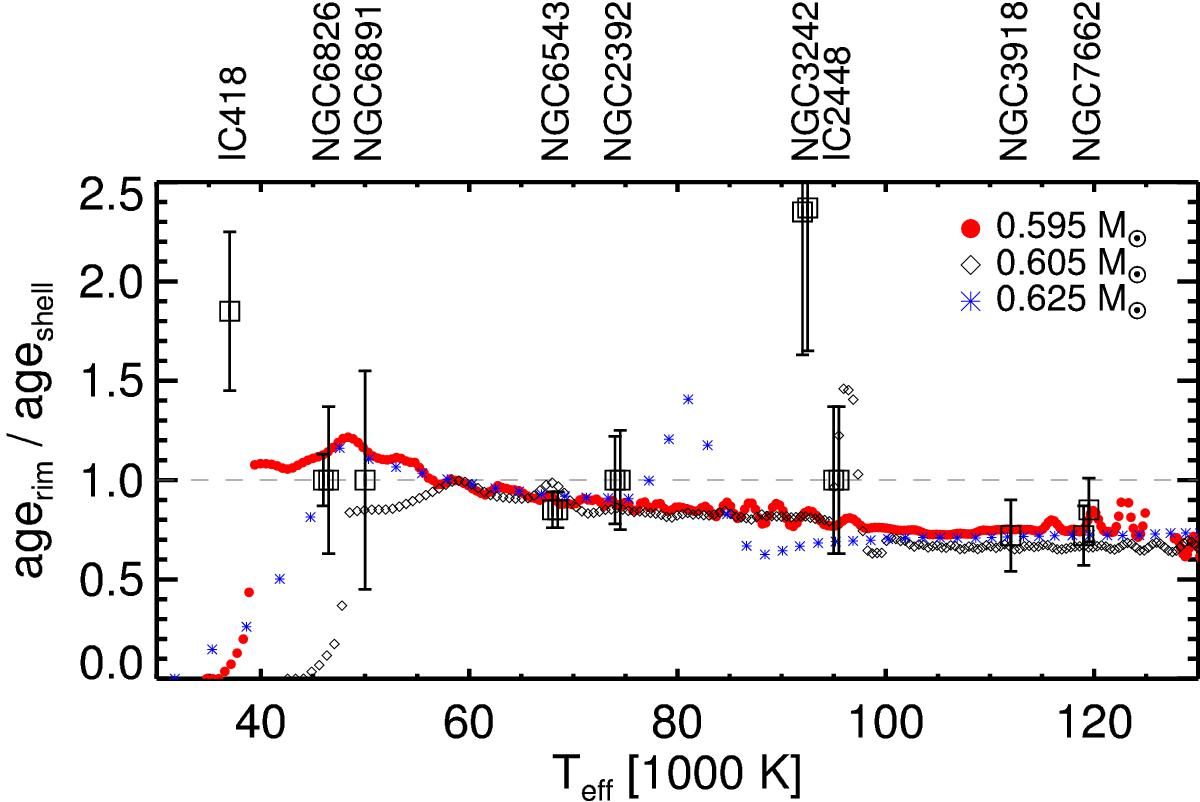Fig. 3

Ratios of measured rim and shell expansion timescales (kinematical ages), i.e. ![]() and
and ![]() , as listed in Table 2 for objects where both values are available, vs. the effective temperatures of the respective central stars. Values from [N ii] data, where available, are offset by +500 K for more clarity. The stellar temperatures are those adopted in Table 8. IC 418 is the only optically thick object of all the shown PNe, and the shell’s shock virtually coincides with the ionisation front. For comparison, the corresponding rim and shell timescales predicted by three hydrodynamical simulations with central stars of 0.595, 0.605, and 0.625 M⊙ already used in previous works (e.g. Schönberner et al. 2014) are also shown (cf. legend). The kinematical age ratio maxima between 50 000 and 60 000 K are typical for the transition from the optically thick to the optically thin stage, i.e. at this moment the radial position of the shell’s shock just coincides with the ionisation front. The peaks at 80 000 K (0.625 M⊙) and 95 000 K (0.605 M⊙), respectively, mark the passage of the He ii ionisation front through the rim-shell interface.
, as listed in Table 2 for objects where both values are available, vs. the effective temperatures of the respective central stars. Values from [N ii] data, where available, are offset by +500 K for more clarity. The stellar temperatures are those adopted in Table 8. IC 418 is the only optically thick object of all the shown PNe, and the shell’s shock virtually coincides with the ionisation front. For comparison, the corresponding rim and shell timescales predicted by three hydrodynamical simulations with central stars of 0.595, 0.605, and 0.625 M⊙ already used in previous works (e.g. Schönberner et al. 2014) are also shown (cf. legend). The kinematical age ratio maxima between 50 000 and 60 000 K are typical for the transition from the optically thick to the optically thin stage, i.e. at this moment the radial position of the shell’s shock just coincides with the ionisation front. The peaks at 80 000 K (0.625 M⊙) and 95 000 K (0.605 M⊙), respectively, mark the passage of the He ii ionisation front through the rim-shell interface.
Current usage metrics show cumulative count of Article Views (full-text article views including HTML views, PDF and ePub downloads, according to the available data) and Abstracts Views on Vision4Press platform.
Data correspond to usage on the plateform after 2015. The current usage metrics is available 48-96 hours after online publication and is updated daily on week days.
Initial download of the metrics may take a while.


